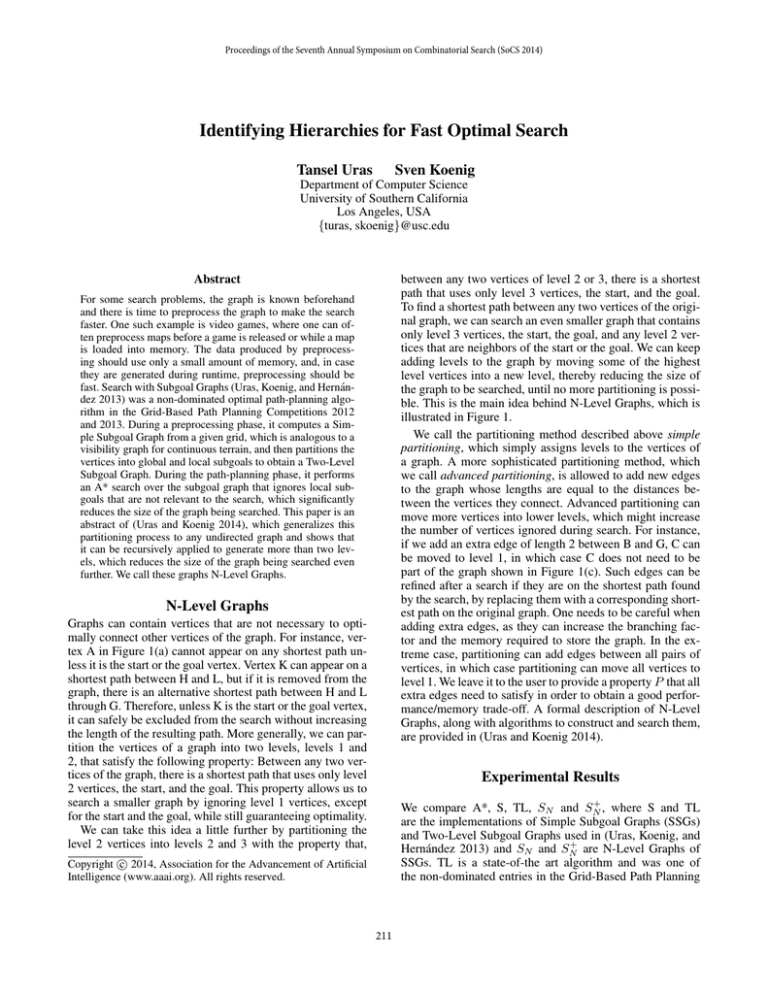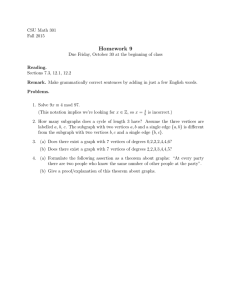
Proceedings of the Seventh Annual Symposium on Combinatorial Search (SoCS 2014)
Identifying Hierarchies for Fast Optimal Search
Tansel Uras
Sven Koenig
Department of Computer Science
University of Southern California
Los Angeles, USA
{turas, skoenig}@usc.edu
Abstract
between any two vertices of level 2 or 3, there is a shortest
path that uses only level 3 vertices, the start, and the goal.
To find a shortest path between any two vertices of the original graph, we can search an even smaller graph that contains
only level 3 vertices, the start, the goal, and any level 2 vertices that are neighbors of the start or the goal. We can keep
adding levels to the graph by moving some of the highest
level vertices into a new level, thereby reducing the size of
the graph to be searched, until no more partitioning is possible. This is the main idea behind N-Level Graphs, which is
illustrated in Figure 1.
We call the partitioning method described above simple
partitioning, which simply assigns levels to the vertices of
a graph. A more sophisticated partitioning method, which
we call advanced partitioning, is allowed to add new edges
to the graph whose lengths are equal to the distances between the vertices they connect. Advanced partitioning can
move more vertices into lower levels, which might increase
the number of vertices ignored during search. For instance,
if we add an extra edge of length 2 between B and G, C can
be moved to level 1, in which case C does not need to be
part of the graph shown in Figure 1(c). Such edges can be
refined after a search if they are on the shortest path found
by the search, by replacing them with a corresponding shortest path on the original graph. One needs to be careful when
adding extra edges, as they can increase the branching factor and the memory required to store the graph. In the extreme case, partitioning can add edges between all pairs of
vertices, in which case partitioning can move all vertices to
level 1. We leave it to the user to provide a property P that all
extra edges need to satisfy in order to obtain a good performance/memory trade-off. A formal description of N-Level
Graphs, along with algorithms to construct and search them,
are provided in (Uras and Koenig 2014).
For some search problems, the graph is known beforehand
and there is time to preprocess the graph to make the search
faster. One such example is video games, where one can often preprocess maps before a game is released or while a map
is loaded into memory. The data produced by preprocessing should use only a small amount of memory, and, in case
they are generated during runtime, preprocessing should be
fast. Search with Subgoal Graphs (Uras, Koenig, and Hernández 2013) was a non-dominated optimal path-planning algorithm in the Grid-Based Path Planning Competitions 2012
and 2013. During a preprocessing phase, it computes a Simple Subgoal Graph from a given grid, which is analogous to a
visibility graph for continuous terrain, and then partitions the
vertices into global and local subgoals to obtain a Two-Level
Subgoal Graph. During the path-planning phase, it performs
an A* search over the subgoal graph that ignores local subgoals that are not relevant to the search, which significantly
reduces the size of the graph being searched. This paper is an
abstract of (Uras and Koenig 2014), which generalizes this
partitioning process to any undirected graph and shows that
it can be recursively applied to generate more than two levels, which reduces the size of the graph being searched even
further. We call these graphs N-Level Graphs.
N-Level Graphs
Graphs can contain vertices that are not necessary to optimally connect other vertices of the graph. For instance, vertex A in Figure 1(a) cannot appear on any shortest path unless it is the start or the goal vertex. Vertex K can appear on a
shortest path between H and L, but if it is removed from the
graph, there is an alternative shortest path between H and L
through G. Therefore, unless K is the start or the goal vertex,
it can safely be excluded from the search without increasing
the length of the resulting path. More generally, we can partition the vertices of a graph into two levels, levels 1 and
2, that satisfy the following property: Between any two vertices of the graph, there is a shortest path that uses only level
2 vertices, the start, and the goal. This property allows us to
search a smaller graph by ignoring level 1 vertices, except
for the start and the goal, while still guaranteeing optimality.
We can take this idea a little further by partitioning the
level 2 vertices into levels 2 and 3 with the property that,
Experimental Results
+
We compare A*, S, TL, SN and SN
, where S and TL
are the implementations of Simple Subgoal Graphs (SSGs)
and Two-Level Subgoal Graphs used in (Uras, Koenig, and
+
Hernández 2013) and SN and SN
are N-Level Graphs of
SSGs. TL is a state-of-the art algorithm and was one of
the non-dominated entries in the Grid-Based Path Planning
c 2014, Association for the Advancement of Artificial
Copyright Intelligence (www.aaai.org). All rights reserved.
211
(a) An undirected graph with unit-length
edges
(b) 3-Level graph of the undirected graph
(c) Graph searched for a shortest path
between F and B
Figure 1: Idea behind N-Level Graphs.
bg512
DAO
starcraft
wc3maps512
maze1
maze2
maze4
maze8
maze16
maze32
random10
random15
random20
random25
random30
random35
random40
room8
room16
room32
room64
Runtime per Instance (ms)
Average Level Partition Time (ms)
+
+
+
A*
S TL SN SN
SN
SN
TL SN
SN
2.69 0.07 0.05 0.06 0.05
26.17
7.59 267
398
284
5.45 0.36 0.13 0.26 0.08
27.70
10.06 229
837
257
24.87 0.94 0.30 0.63 0.18
71.12
14.43 8657 59334 8912
5.52 0.08 0.06 0.07 0.06
28.44
9.22 313
376
379
15.73 3.84 3.39 0.47 0.45 1263.60 1138.40
45 22697 21230
29.95 2.53 1.78 0.33 0.30 832.20 675.60
48 9536 7864
42.99 1.04 0.49 0.21 0.18 407.80 179.90
36 1654
697
52.65 0.39 0.23 0.16 0.15 228.60 101.30
12
299
140
59.24 0.18 0.14 0.12 0.12 105.70
47.20
4
47
29
59.23 0.09 0.10 0.08 0.09
39.00
17.60
2
5
6
3.93 1.52 1.44 1.52 1.30
7.60
13.70 875 1900 6430
6.32 2.70 2.40 2.67 2.17
7.80
11.10 685 2003 4268
8.37 3.69 3.12 3.56 2.75
9.70
12.20 533 2332 3706
10.00 4.40 3.57 4.03 2.87
12.20
13.50 421 2554 3172
11.15 4.77 3.58 3.98 2.57
17.60
14.30 324 2984 2509
12.65 5.27 3.61 3.66 2.09
27.30
22.70 244 3340 2647
12.16 4.84 3.05 2.51 1.22
39.50
32.30 126 2281 1645
15.37 0.65 0.57 0.64 0.54
8.40
7.40
35
164
206
16.75 0.17 0.16 0.17 0.15
6.90
7.10
9
33
54
19.60 0.07 0.07 0.07 0.06
7.30
5.70
3
8
13
23.61 0.04 0.05 0.04 0.04
6.40
6.70
1
2
5
tors of 3.5 and 3.2, respectively), which demonstrates the
benefits of adding extra edges during partitioning. SN is
generally slower than TL, except on maze maps. TL is faster
than SN by a factor of 2.1 on StarCraft maps. On the other
hand, SN is faster than TL by a factor of 7.2 on maze maps
with corridor width 1. These results show that the structure
of the graph can have a significant impact on the performance increase obtained by adding extra edges during partitioning and by partitioning the vertices into more levels. For
instance, StarCraft maps have lots of diagonal obstacles that
result in a large number of subgoals. Many of them can be
partitioned into the lowest level by adding h-reachable edges
between them. On the other hand, mazes have lots of bending corridors, which limits the number of h-reachable edges
that can be added.
Conclusions
N-Level Graphs are constructed from undirected graphs by
partitioning the vertices into levels to create a hierarchy,
which allows searching for shortest paths while ignoring
parts of the graph. The main idea of using hierarchies to
ignore parts of the graph during search is similar to MultiLevel Graphs, but the means of achieving this is very different. For instance, for N-Level Graphs, one needs to specify an edge connection strategy whereas, for Multi-Level
Graphs, one needs to specify the levels of the vertices. We
demonstrate the effectiveness of N-Level Graphs on grids by
improving the state-of-the-art of path planning on grids. Future research includes application of these methods to different domains, investigation of whether stopping partitioning
early increases performance, and exploration of new techniques for partitioning and search.
Table 1: Results of different subgoal graphs
Competition (GPPC) in 20121 . SN is constructed from an
+
SSG using simple partitioning, whereas SN
is constructed
from an SSG using a version of advanced partitioning that is
allowed to add h-reachable edges (defined in (Uras, Koenig,
and Hernández 2013)). We compare the methods on different map types, all of which are available from Nathan Sturtevant’s repository2 . For each map type, Table 1 shows the average runtime per instance for all methods, the average num+
ber of levels for SN and SN
, and the average preprocessing
+
time for TL, SN , and SN needed for partitioning.
+
The results show that, in general, SN
is the fastest method,
+
followed by TL, SN , S, and finally A*. SN
is faster than
TL by a factor of 1.6 on Dragon Age: Origins and StarCraft
maps, a factor of 7.5 on maze maps with corridor width 1,
and a factor of 2.5 on maps with 40% randomly blocked
cells. Its performance is comparable to TL on other game
maps and room maps. It is faster than A* by a factor of 193
+
on StarCraft maps. SN
is generally faster than SN , especially on Dragon Age: Origins and StarCraft maps (by fac1
2
Acknowledgments
Our research was supported by NSF under grant number IIS1319966 and ONR under grant number N00014-09-1-1031.
References
Uras, T., and Koenig, S. 2014. Identifying hierarchies for fast
optimal search. In Proceedings of the 28th AAAI Conference on
Artificial Intelligence.
Uras, T.; Koenig, S.; and Hernández, C. 2013. Subgoal graphs
for optimal pathfinding in eight-neighbor grids. In Proceedings
of the 23rd International Conference on Automated Planning and
Scheduling.
http://movingai.com/GPPC
http://movingai.com/benchmarks/
212






